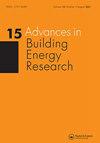Assessment of the impact of construction materials on the building’s thermal behaviour and indoor thermal comfort in a hot and semi-arid climate
IF 2.5
Q2 CONSTRUCTION & BUILDING TECHNOLOGY
引用次数: 4
Abstract
ABSTRACT This paper aims to identify the most suitable construction materials in terms of building’s energy performance and indoor thermal comfort for a hot and semi-arid climate. An experimental validated TRNSYS-based numerical model was set to carry out dynamic simulations for the energy performance assessment of four similar houses built with different materials, namely Cinder Blocks, Reinforced Concrete, Fired Bricks, or Rammed Earth. The results show that the rammed earth house had the best thermal performance thanks to its high thermal mass, which helped maintain a stable indoor air temperature for optimal thermal comfort. Adding shading and night natural ventilation contributed to the further improvement of the rammed earth house's thermal performance. Indeed, the annual heating/cooling load of the rammed earth house was 23%, 11% and 3% lower than the reinforced concrete, cinder blocks and fired bricks houses, respectively. These thermal load differences were much more reduced to 51%, 24% and 5%, respectively, after adding the shading and night natural ventilation techniques. Furthermore, this study evaluated the use of low embodied energy and weak carbon footprint construction materials to achieve a good building's thermal performance and acceptable indoor thermal comfort.评估建筑材料在炎热和半干旱气候下对建筑物热性能和室内热舒适的影响
摘要:本文旨在确定在炎热和半干旱气候下最适合建筑能源性能和室内热舒适的建筑材料。采用实验验证的trnsys数值模型,对使用煤渣砖、钢筋混凝土、烧结砖或夯土等不同材料建造的四座类似房屋进行了能源性能评估的动态模拟。结果表明:夯土房屋具有较高的热质量,能够保持室内空气温度稳定,达到最佳的热舒适性。增加遮阳和夜间自然通风有助于进一步改善夯土房屋的热性能。夯土房屋的年热/冷负荷分别比钢筋混凝土、煤渣砖和烧砖房屋低23%、11%和3%。在增加遮阳和夜间自然通风技术后,这些热负荷差异分别减少到51%,24%和5%。此外,本研究评估了低隐含能量和低碳足迹的建筑材料的使用,以实现良好的建筑热工性能和可接受的室内热舒适。
本文章由计算机程序翻译,如有差异,请以英文原文为准。
求助全文
约1分钟内获得全文
求助全文
来源期刊

Advances in Building Energy Research
CONSTRUCTION & BUILDING TECHNOLOGY-
CiteScore
4.80
自引率
5.00%
发文量
11
 求助内容:
求助内容: 应助结果提醒方式:
应助结果提醒方式:


